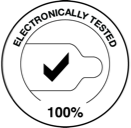Condom manufacturing: What’s behind the certifications?
Condoms production is a tightly regulated area. You might think you can make your own in your kitchen sink… well, not quite, and that’s a good thing!
As you might know, the main ingredient for condom manufacturing is latex. Latex is the hevea sap, and it comes out as a white viscous liquid collected from the hevea tree. In that state, its viscosity varies with temperature, and it is not yet in a condition where you can make a thin, holeless film out of it.
The latex needs to be transformed, and it’s done mainly by adding several ingredients (check out the ones we use) that will alter the chemical composition of the mix to facilitate production. Once those ingredients are added, penis-shaped glass rods are dipped into the latex bath to make the condoms.
For safety and reliability reasons, it’s essential that the condoms have the same elasticity, resistance and have absolutely no holes. To ensure that each condoms manufacturer produces quality products, there are several norms and certificates to obtain to sell the condoms across the world.
ISO 4074
Condoms are mass-produced devices. To guarantee quality, the standard ISO 4074 describes requirements and test methods for natural rubber latex male condoms. It covers many aspects, ranging from lot sizes, biocompatibility, product claims, bursting volume and pressure, 100% electronic testing requirements, stability and shelf life, freedom from holes and visible defects. It also provides detailed information on how to conduct the tests.
For example, the determination of the bursting volume and pressure is done by inflating the condom with air in a controlled environment until it bursts, recording the volume and pressure at which it did. Testing for holes can be done through two methods: (1) The condom is filled with a specified volume of water and examined for leakage. (2) The condom is filled with liquid and plunged in a second liquid. An electronic current is given to the inside liquid. If the current is measurable in the second liquid, the condom has a hole as it did not insulate the two liquids properly.
ISO 13485
Condoms are Class II medical devices. To produce medical devices of a consistent standard, a well-run factory has an audited, documented and effective quality management system. ISO has a quality management system standard described specifically for medical devices production in ISO 13485. It requires documented quality objectives, management responsibilities, training procedures, process and quality assistance procedures, systematic record-keeping and remedial action in case of product quality problems.
Additionally, factories should remain in control of all incoming raw materials and have appropriate testing and controls, both in-process and for finished products. Condoms are non-sterile devices but should nevertheless be free from contamination and adulteration. This is achieved by manufacturing in a controlled environment with periodic monitoring to ensure no contamination and bioburden levels maintenance within acceptable limits.
CE - EU Standard
Condoms intended for sale or distribution within the European Union must carry the CE mark, which verifies that the product meets the essential requirements of the medical device directive 93/42/EEC and 2007/47/EC. Manufacturers are required to follow specific conformity assessment procedures that include submitting a dossier to a European Notified Body. Compliance with ISO 4074 can be taken as evidence of compliance with the essential requirements of the medical device directive. Manufacturing facilities are required to be ISO 13485 certified.
ISO 9001
Quality management systems standards are designed to help organizations ensure that they meet customers and stakeholders needs while meeting statutory and regulatory requirements related to a product or program. ISO 9001 describes the requirements that organizations wishing to meet the standard must fulfill. The standard is based on seven quality management principles: customer focus, leadership, engagement of people, process approach, improvement, evidence-based decision making, relationship management. Working with an ISO 9001 supplier guarantees risks have been identified within their organizations, they put the customer first and work in a more efficient way as all their processes are aligned and understood by everyone.
OUR CERTIFICATIONS
To choose the production site for the Green Condoms, we contacted over 40 condom manufacturers worldwide with two requests: the condoms must be vegan, and the ingredients used for manufacturing will be disclosed on the packaging. Only one factory, in China, agreed to both conditions. Our founder Gabrielle personally went to the production site to audit the facility and processes in February 2017. Additionally, the authenticity of each certificate CE, ISO 13485 and ISO 9001 have been verified. Those certificates are obtained after the facility passes audits done by a third party organization, every 3 years for ISO and every 5 years for CE. Regular voluntary controls are conducted more frequently internally. Finally, it is worth noting that the ISO 4074 standard cannot be certified as such, therefore doesn’t have a certificate attached to it (unlike ISO 13485 and ISO 9001).
Do you have any questions? Email us at fun@green-change.ch, we will be happy to answer you!

















Let's be honest: what is the first thought that comes to your mind when you hear about scheduling sex? Boring. Laborious. So-not-sexy. Yet, many sexologists swear by this practice to cultivate intimacy within a relationship.